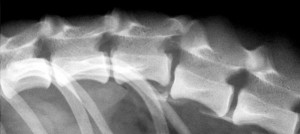News
Pet of the month – October 2019
by admin on October 1st, 2019
Category: Pet of the Month, Tags:
We had a very lovely visitor today, meet Princess Buttercup!
Four years ago she came to us as a stray and suffering from a condition called Hydrocephalus, which means she had an increased volume of fluid surrounding her brain.
We also found out shortly after her arrival that she was pregnant and she gave birth at the practice a couple of weeks later!
Now all her kittens have grown up and been rehomed, Buttercup lives in a wonderful home and enjoys a very happy life.
Here she is having her annual vaccination.
Nasal Disease
by admin on September 2nd, 2019
Category: News, Tags:
What diseases can affect the inside of the nose?
There are several different types of problem that can affect the nasal cavity of dogs and cats. The most common conditions in dogs include inflammation of the nasal cavity (rhinitis) and nasal tumours (cancer). Rhinitis in dogs can be due to a number of problems including allergy (called lymphoplasmacytic rhinitis), fungal infection (most commonly a fungus called Aspergillus) and foreign bodies (such as grass blades). In cats fungal disease is rare, whilst polyps (benign outgrowths of tissue) in the nose/ throat, rhinitis of unknown cause and tumours are more common. Bacterial infection can occur as a consequence of the underlying disease but does not cause nasal disease by itself.
What are the signs of nasal disease?
- Sneezing
- Snorting
- Nasal discharge
- Nose bleeds
- Nasal pain
- Nasal ulceration or loss of pigment around the nostrils
- Reverse sneezing (this can look like spasms of choking or difficulty breathing and can be quite disturbing to see but is not a life threatening problem)
How is nasal disease diagnosed?
Bloods tests may be performed as part of an initial investigation, looking at general organ health prior to performing an anaesthetic or other tests. Sometimes blood tests are performed to look at how well the patient’s blood is clotting in patients with nose bleeds. Most commonly X-rays or a CT scan of the nasal cavity are performed under general anaesthesia and a procedure called rhinoscopy is carried out, in which an endoscope camera is inserted up the nose or used to look at the back of the throat.
Nasal X-rays may show damage to the small bones in the nose and they may reveal the presence of fluid or tumours. X-rays can sometimes look normal even when nasal disease is present, however.
A CT scan is a much more effective and sensitive way of detecting disease in the nose and will not uncommonly reveal abnormalities that haven’t shown up on an X-ray. A CT scan will also help to define the extent of any damage or the location of a tumour.
Rhinoscopy (passing a small camera inside the nose) is performed to look for abnormalities including fungal infection, tumours, and foreign bodies and to help take a tissue biopsy from the nose to send for analysis.
How is nasal disease treated?
The treatment for nasal disease depends upon its underlying cause and severity. Sometimes medication in the form of tablets is prescribed; anti-fungal solution must be put into the nose or the sinuses to treat the fungal infection Aspergillus, whilst either radiation therapy or chemotherapy may be required for the treatment of nasal tumours.
What is the long term outlook (prognosis)?
The long term outlook depends upon the underlying disease. Patients usually recover well from removal of a foreign body. Allergic rhinitis is not a life-threatening problem, but treatment is generally aimed at controlling rather than curing the problem and some patients may not respond as well as would be hoped. Aspergillus can respond well to therapy, but the condition may be recurrent and difficult to cure in some patients.
More specific advice and guidance about treatment of nasal disease for individual patients can be given once the diagnosis has been made and detailed information has been obtained from the diagnostic work-up.
Pet of the month – September 2019
by admin on September 2nd, 2019
Category: Pet of the Month, Tags:
Although Max has reached his target weight on Sienna’s weight clinics, his owner still pops him in every 3 months to check his weight is stable.
If you haven’t heard of our weight clinics, for a £5 joining fee you and your pet receive a weight management booklet with tips on keeping your pet at a healthy weight, body condition score chart, measuring cup, calorie chart of common treats, food diary and leaflets on foods available to help your pet lose weight. All follow up appointments are free of charge.
Phone today to book an appointment with our weight management nurse Sienna!
Spinal Fractures
by admin on August 1st, 2019
Category: News, Tags:
Spinal Fractures
Fractures (breaks) of the spine occur when dogs and cats are involved in road traffic accidents or suffer other major trauma such as a fall or running into a patio door. Spinal fractures are often associated with varying degrees of injury to the spinal cord (the bundle of nerves inside the vertebrae) and, therefore, nerve damage. Although many animals may be paralysed as a result of the fracture, they will often recover, provided that they retain the ability to feel pain and that they are managed appropriately. Some cases can be treated medically, but it is often necessary to consider surgery to stabilise a fractured spine.
What is involved in a spinal fracture?
In a spinal fracture, the bones (vertebrae) of the spine break (fracture) or come apart from each other (dislocate or luxate). Fracture of the spine usually occurs as a result of a significant injury, such as being hit by a car, although occasionally the bones in the spine may fracture with minimal, if any, trauma because they are already weakened by a condition such as a tumour (referred to as a ‘pathological fracture’).
When the vertebrae of the spine fracture or dislocate (luxate) the associated vertebral displacement often injures the nerves of the spinal cord. The concussion and compression of the spinal nerves affects nerve function, and the signs that develop may vary from only mild weakness through to paralysis (inability to voluntarily move the limbs). Severely affected patients may become incontinent and lose the ability to feel pain in their limbs and tail.
How are spinal fractures diagnosed?
Physical examination of the patient by the specialist may enable detection of instability of the spine or abnormal alignment of the spine. Importantly, examination also enables assessment of the severity of any associated spinal cord injury – in particular, whether or not the patient can still feel pain.
X-rays (radiographs) are often obtained to look for evidence of fracture (or luxation) of the vertebrae and are generally sufficient to make a diagnosis in the majority of cases. Occasionally a more advanced imaging technique is preferred, to provide additional detail of the spine. CT scanning is particularly good at looking at the bony detail of fractures which may not be apparent on normal X-rays. MRI scanning is not so good at detecting damage to bones of the spine, but it is excellent for assessing any damage to the spinal cord.
How are spinal fractures managed?
Spinal fractures (and luxations) are often emergencies because of the associated spinal cord injury and risk of further damage. As a result, they need to be treated with the minimum of delay. Affected dogs and cats are often in significant pain, and care should be taken to avoid the handler being bitten or scratched. Patients should be moved with great caution in case the spine (vertebral column) is unstable, as further movement may aggravate the injury and any nerve damage. Strapping the patient to a rigid board may be helpful in some cases.
Some fractures of the spine may be treated conservatively without the need for surgery. This is particularly appropriate in patients with relatively stable vertebrae and minimal spinal cord injury. Conversely, dogs and cats with unstable fractured spines, those with significant spinal cord injuries and those in severe pain are often best treated surgically. Surgery aims to re-align and stabilise the affected vertebrae. The procedure most often involves placing screws or pins in the bones on either side of the fracture (or luxation) and securing them with either a plate or cement.
What is the outlook (prognosis) in patients with spinal fractures?
The outlook in dogs and cats with spinal fracture is primarily dependent on the severity of the spinal cord injury and how the patient is treated. Provided the ability to feel pain in the limbs and tail is maintained and the patient is managed appropriately, the outlook is generally good. Recovery may take a number of weeks (or even months in severely affected cases) and supportive care, including physiotherapy/hydrotherapy exercises, may be necessary. In contrast, patients with spinal fractures that can no longer feel pain are very unlikely to recover, no matter how they are treated, since the spinal cord injury is generally severe and irreversible.
Pet of the month – August 2019
by admin on August 1st, 2019
Category: Pet of the Month, Tags:
Our Pet of the Month is the delightful Rascal, seen here recovering from removal of his anal sacs. Rascal had the misfortune to suffer months of anal sac issues ranging from impaction to infection with associated pain and discomfort, making anal sac removal the only viable way forward.
What are the anal sacs?
The anal sacs are two small pouches located on either side of the anus at approximately the four o’clock and eight o’clock positions. The walls of the sac are lined with a large number of sebaceous (sweat) glands that produce a foul smelling fluid. The fluid is stored in the anal sacs and is released through a small duct or canal that opens just inside the anus. The anal sacs are commonly called ‘anal glands’. The sacs are present in both male and female dogs.
What is their function?
The anal sac secretion contains chemicals that act as territorial markers or ‘dog calling cards’. The secretions are similar to those produced by a skunk, which are used to repel enemies and alert other animals to their presence. Anal sac fluid is usually squeezed out by muscular contractions whenever the dog passes a bowel movement, providing a distinctive odor (or individual ‘scent signature’) to the feces. This is why dogs are so interested in smelling one another’s feces.
Why are the anal sacs causing a problem in my dog?
Anal sac disease is very common in dogs. The sacs frequently become impacted (plugged) usually due to inflammation of the ducts. The secretion within the impacted sacs will thicken and the sacs will become swollen and distended. It is then painful for your dog to pass feces. The secreted material within the anal sacs is an ideal medium for bacterial growth, allowing abscesses to form. Bacteria that are normally present in the feces can readily travel up the ducts and enter the sacs. In normal situations, the bacteria are flushed out when the secretions are expelled during a bowel movement. However, if the sacs are impacted, the fluid does not empty normally and they become infected. The fluid then becomes bloody and eventually the sacs become filled with pus, forming an anal sac abscess.
The abscess will appear as a painful, red, hot swelling on one or both sides of the anus. If the abscess bursts, it will release a quantity of greenish yellow or bloody pus. If left untreated, the infection can quickly spread and cause severe damage to the anus and rectum.
Another cause of recurrent anal sac disease is change in stool consistency. This can occur in dogs with gastrointestinal diseases such as food allergies and inflammatory bowel disease.
How will I know if my dog has anal sac problems?
The first sign is often scooting or dragging the rear along the ground. There may be excessive licking or biting, often at the base of the tail rather than the anal area. Anal sac disease is very painful. Even normally gentle dogs may snap or growl if you touch the tail or anus when they have anal sac disease. If the anal sac ruptures, you may see blood or pus draining from the rectum.
How is anal sac disease treated?
Treatment for impaction involves expressing or emptying the sacs. If the impaction is severe or if there is an infection, it may be necessary to flush out the affected sac to remove the solidified material. Since these conditions are painful, some pets require a sedative or an anesthetic for this treatment. Antibiotics are often prescribed and sometimes may need to be instilled into the sacs. Most dogs will require pain relief medications for several days until the swelling and inflammation have subsided. In advanced or severe cases, surgery may be necessary.
Problems with the anal sacs are common in all dogs, regardless of size or breed. If you are concerned that your pet may have an anal sac problem, call your veterinarian.
Is the condition likely to recur?
Some dogs will have recurrent anal sac impactions or abscesses. Overweight dogs tend to have chronic anal sac problems because their anal sacs do not empty well. Each impaction may cause further scarring and narrowing of the ducts, leading to recurrences that are even more frequent. If this condition recurs frequently, surgical removal of the sacs is indicated. If the cause of anal sac disease is change in stool consistency, prevention involves treating the underlying cause and may require changing the dog to a higher fibre diet.
Are anal sacs necessary for my dog? Will removal have any adverse effects?
Anal sacs produce the pungent smelling secretion that allows the dog to mark his or her territory. For our domesticated dogs, this is an unnecessary behavior and removal will not adversely affect your pet.
Are there any risks associated with surgical removal of the anal sacs?
Removal of the anal sacs is a delicate and specialized surgery. Some dogs will experience loose stools or lack of bowel control for one to three weeks following surgery. This occurs because the nerves controlling the anal sphincters (muscles that close the rectum) run through the soft tissues near the anal sacs. If the infection is deep and extensive it can be impossible to avoid damaging the nerves during the surgery. This damage resolves without further treatment in the majority of pets. In rare cases, the nerve damage is permanent and can result in fecal incontinence or the inability to control bowel movements, with constant leakage of feces from your dog’s anus.
As with any surgery, general anesthesia is required which always carries some degree of risk. Advances in anesthesia drugs and monitoring continue to decrease these risks. For dogs suffering from chronic or recurrent anal sac infection or impaction, surgical removal is the best option to relieve the pet’s pain.
What other problems can develop with the anal sacs?
Older dogs can develop cancer of the glands within the anal sacs called adenocarinoma. Therefore, it is very important to have your dog examined by a veterinary as soon as any of the above clinical signs are seen.
Pancreatitis in Dogs
by admin on July 3rd, 2019
Category: News, Tags:
What is pancreatitis?
The pancreas is an organ in the abdomen (tummy) which is responsible for releasing enzymes (types of proteins) to digest food. The pancreas also releases important hormones (such as insulin) into the bloodstream. Pancreatitis occurs when the pancreas becomes inflamed (tender and swollen). In most cases pancreatitis occurs for no apparent underlying reason, although sometimes it can have a particular cause (such as scavenging food). Pancreatitis most commonly affects middle aged to older dogs, but in addition, dogs of certain breeds (e.g. Cocker Spaniels and Terrier breeds) are more prone to developing the condition.
What are the signs of pancreatitis?
Pancreatitis can cause a variety of symptoms, ranging from relatively mild signs (e.g. a reduced appetite) to very severe illness (e.g. multiple organ failure). The most common symptoms of pancreatitis include lethargy, loss of appetite, vomiting, abdominal pain (highlighted by restlessness and discomfort) and diarrhoea.
How is pancreatitis diagnosed?
The possibility that a dog may be suffering from pancreatitis is generally suspected on the basis of the history (i.e. loss of appetite, vomiting, etc) and the finding of abdominal pain on examination by the veterinary surgeon. Because many other diseases can cause these symptoms, both blood tests and an ultrasound scan of the abdomen are necessary to rule out other conditions and to reach a diagnosis of pancreatitis. Although routine blood tests can lead to a suspicion of pancreatitis, a specific blood test (called ‘canine pancreatic lipase’) needs to be performed to more fully support the diagnosis. An ultrasound scan is very important in making a diagnosis of pancreatitis. In addition, an ultrasound scan can also reveal some potential complications associated with pancreatitis (e.g. blockage of the bile duct from the liver as it runs through the pancreas).
How is pancreatitis treated?
There is no specific cure for pancreatitis, but fortunately most dogs recover with appropriate supportive treatment. Supportive measures include giving an intravenous drip (to provide the body with necessary fluid and salts) and the use of medications which combat nausea and pain. Most dogs with pancreatitis need to be hospitalised to provide treatment and to undertake necessary monitoring, but patients can sometimes be managed with medication at home if the signs are not particularly severe. At the other extreme, dogs that are very severely affected by pancreatitis need to be given intensive care.
One of the most important aspects of treating pancreatitis is to ensure that the patient receives sufficient appropriate nutrition while the condition is brought under control. This can be very difficult, because pancreatitis causes a loss of appetite. In this situation it may be necessary to place a feeding tube which is passed into the stomach, and through which nutrition can be provided. If a dog with pancreatitis is not eating and will not tolerate a feeding tube (e.g. due to vomiting), intravenous feeding (using a drip to supply specially formulated nutrients straight into the bloodstream) may be necessary.
What is the outcome in pancreatitis?
It may be necessary for dogs with pancreatitis to be hospitalised for several days, but fortunately most patients with the condition go on to make a complete recovery, provided that appropriate veterinary and nursing care is provided. In some instances, dogs can suffer repeated bouts of the condition (called ‘chronic pancreatitis’) and this may require long term management with dietary manipulation and other approaches which the specialist will discuss with you in detail, as required.
Pet of the month – July 2019
by admin on July 3rd, 2019
Category: Pet of the Month, Tags:
Meet Dylan…
He came to us today because he was licking his front foot. On examination one of our vets found a small sore lesion between his toes. An anaesthetic was required to examine his foot and open up the lesion in which a grass seed was found!
This is not the first time Dylan has been so unfortunate. Last time a total of 16 grass seeds were found amongst all 4 of his feet!
Sensible precautions at this time of year are:
- Avoid long grass in the summer months
- Maintain your own lawn
- Throughly check your pet after walks, particularly feet, ears, eyes and mouth.
- Ensure your pet is regularly groomed, especially if they have a long or thick coat.










